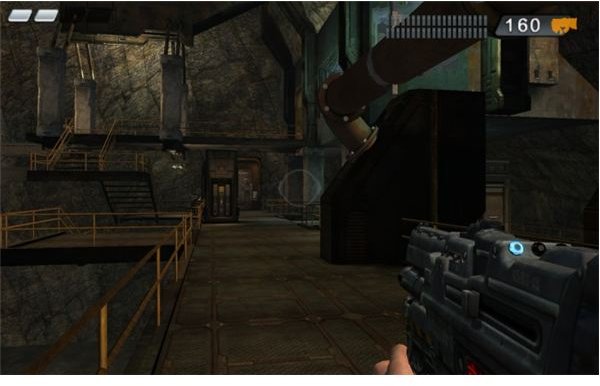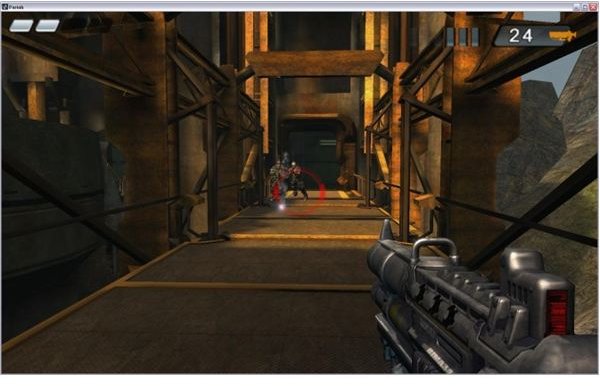Pariah PC Review - Review of Pariah PC Game, a First-Person Shooter by Digital Extremes

Overview of Pariah
In Pariah you play the role of Dr. Jack Mason who has been drafted to escort a virus-ridden female prisoner placed into cryostasis from a maximum security prison back to Milcom Headquarters. However, soon after takeoff of your shuttle, it comes under fire over enemy territory and is shot down.
Compromised, the prisoner escapes the cryocasket and Mason becomes infected with the virus after an encounter with her at the crash site. The enemy then captures her and poor Jack must rescue her in order to find and contain the virus.
He does this by blasting his way through 18 levels of gameplay which both entertain and frustrate in equal measure in a sometimes complicated and mostly confusing plot.
Pariah Gameplay (3 out of 5)
Pariah plays just like any other first-person shooter – find gun, shoot enemies, heal, flick a switch, shoot enemies, advance. Repeat ad finitum. It gets quite repetitive after a while, especially as there’s little variation in the enemies you’ll face.
There are a wide array of weapons available in the game and each can be upgraded with extra features to make them more powerful, which is just as well as the weapons are on the whole pretty weedy in terms of clout. The guns are generally underpowered and it isn’t uncommon to take a full clip to down a solitary enemy, so forget any notions of headshot kills.
There are some drivable vehicles interspersed in the game, which, while fun to drive and handle pretty well – better than those in Farcry, for instance – are rather weak in defence, and easily destroyed by enemy fire.
For healing, there’s no med-pack available. Instead you carry a tool which you have to equip and use like a weapon if you want to heal yourself. The device uses ‘ammo’ and each charge heals one bar of health. It can be recharged by finding other such tools scattered across the level and also by retrieving those dropped by enemies. This is a neat idea, although the health system is rather Halo-like in that your health is represented by 4 bars which can regenerate during periods of inactivity. Overall it’s a little unbalanced as healing-tool refills are plentiful in the game and it’s generally difficult to run out of the ability to heal.
The game is built on the Havoc physics engine and scenery interaction is one facet of gameplay that Pariah does well, allowing the character to roll explosive barrels towards enemies before detonating them with a well-placed shot, while pipes can be pierced with bullets to release clouds of steam which can act as cover. Bullet-fire and explosions rip out the scenery, and chunks of masonry can be shot out of pillars making gunfights a little more realistic.
Enemy AI is also lacking somewhat, as enemies will either try to rush you or keep their distance and seem to be caught in a loop; if they rush they might suddenly drop into cover and try to down you with gunfire or equally could begin to run away before rushing and then running away again. Overall, it seems that the AI doesn’t quite know what it wants to do.
Pariah Screenshots



Pariah Graphics & Sound (4 out of 5)
Pariah is punctuated by cutscenes – a lot of cutscenes – which are unfortunately rendered in low-res and look quite bad, although to be fair they aren’t indicative of the graphics in game which are both fluid and pretty, but can occasionally appear blocky – even at a resolution of 1680x1050 – than expected.
While there is a clear Halo influence about the way the game displays, it is let down somewhat by a poor selection of textures for enemies and death animations and you’ll feel like you keep downing the same poor guy time after time.
Sound in the game is somewhat weak which gives further rise to the feeling of the weapons being underpowered although the soundtrack and voice acting in the cut-scenes is on a par with the best in the genre and seamlessly fits the game environment.
Pariah System Requirements (4 out of 5)
Even upon first release, Pariah wasn’t an overly intensive, hardware reliant game and would run happily on any mid-high spec PC. Nowadays it should be well within range of most PCs.
Pariah’s system requirements are:
- Intel Pentium IV 1.4ghz (or AMD Athlon XP equivalent);
- Windows 98SE/2000/XP (95/NT not supported);
- 256 MB System RAM;
- 32 MB GeForce 3 or better 100% DirectX 8.x compatible 3D graphics cards;
- 100% DirectX 8.x compatible Sound Card Quad Speed
- (4X) CD-ROM drive;
- 2GB free disk space
In the UK, Pariah has been rated 16+ by PEGI, due to the levels of profanity used in the game, especially during cutscenes.
Other Game Modes (3 out of 5)
In addition to the standard single player campaign, Pariah also features a multiplayer option, which offers all the standard fare typically associated with other FPS games including deathmatch, team deathmatch, and captures the flag. However, the offering is in general rather weak and you’ll be pushed to find many servers hosting Pariah.
There is also a mapmaker function which allows you to design your own custom maps for multiplayer use. The mapmaker is pretty easy to use and is replete with features but unless you’re keen on playing Pariah on a local area network, or hosting your own Pariah server online, there’s nothing much in the mapmaker to really make it worthwhile.
Verdict on Pariah (3 out of 5)
The sum of Pariah’s parts is enough to earn it a tentative ’thumbs up’, but it could have and should have been better than it ultimately is. Unfortunately for Pariah, it also has perhaps lived up to its moniker too much and suffered from having been released around the same time as many of the top-end shooters, such as Half-Life 2 and Halo ,meaning it was always going to be an uphill struggle for the game to get noticed.
However, while being a solid enough first-person shooter, the game’s numerous flaws haven’t helped Pariah rise to the higher echelons of the genre and Digital Extremes have perhaps tried too hard to make Pariah into another Halo, rather than simply concentrate on it being Pariah, and a worthwhile game in its own right.
The often confusing storyline isn’t helped by the numerous cutscenes which pepper the game but fail to sufficiently pad out the story, while some weak level design and weaker weapons struggle to hold Pariah’s head above water in a crowded FPS market.
Players will get some enjoyment from Pariah, but it will be short-lived and the game is unlikely to feature long on most people’s PCs after completion.
